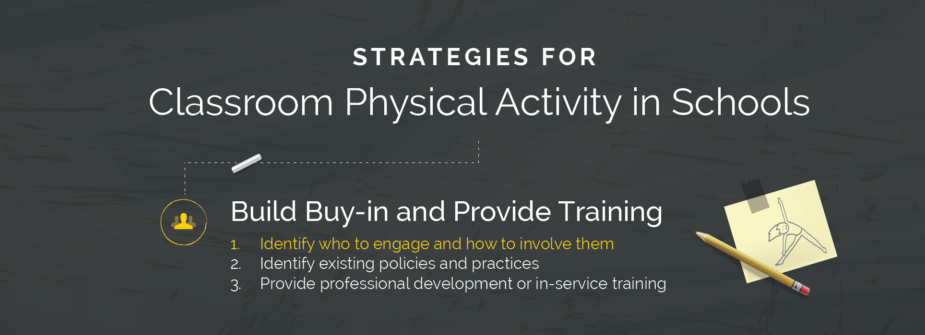Identify who to engage and how to involve them in planning for classroom physical activity.
Leveraging existing relationships and creating new ones can increase the use of classroom physical activity. Some school administrators and teachers may be willing to serve as physical activity champions and role models to show the benefits and ease of implementing classroom physical activity and to help build buy-in among other administrators and teachers. Other groups that may be available to support these efforts include school wellness committees or teams that are already working to address classroom physical activity as part of their Comprehensive School Physical Activity Program plan.
With appropriate support and training, physical education teachers can serve as a resource to promote best practices and techniques for classroom physical activity. Schools may also have a physical activity champion known as the physical activity leader (often, but not necessarily, the physical education teacher) who can lead the development of a Comprehensive School Physical Activity Program plan that includes classroom physical activity.
Evidence has shown that teacher and student buy-in is essential for the success of classroom physical activity. Challenges that prevent teachers from implementing classroom physical activity include teaching philosophies and priorities that do not include physical activity, space constraints, and limited time for physical activities.
The best way to overcome these challenges is to work with teachers to identify solutions and with school administrators to ensure direct support and encouragement. Students, especially those in upper elementary school grades and in middle and high school, can be asked to serve as student champions and design, select, and lead classroom physical activities. Assessing teacher and student interest might be the first step to identifying existing champions, cultivating new champions, and ultimately implementing classroom physical activity.
Parents and community members can support these efforts by communicating with administrators and teachers about the benefits of classroom physical activity, advocating for and volunteering to help with activities, and sharing specific ideas with teachers. Creating partnerships with universities and community organizations, like local nonprofits that work with children and adolescents, can expand support and potentially provide resources for classroom physical activity.
Citations can be found in Strategies for Classroom Physical Activity in Schools.
Key Activities
Put Strategy 1 into practice through the following activities:
✓ Brainstorm a list of individuals and groups within and beyond the school community who could support or be engaged in the adoption, promotion, enhancement, or sustainability of classroom physical activity.
✓ Use this list to identify the level of influence and interest of each potential partner to help you adopt, promote, enhance, and sustain classroom physical activity practices.
✓ Prioritize who to engage and identify how you might reach them—for example, by talking with parents at parent-teacher association meetings or building teacher buy-in through professional development opportunities.
✓ Revisit your partner list periodically to continue to recruit champions and expand buy-in for classroom physical activity.
Questions for Consideration
Use the following questions to guide key activities and inspire new ideas:
– Which decision makers, champions, and potential advocates need to be engaged to build support for classroom physical activity practices or policies?
– How can physical education teachers support classroom physical activity as an integrated part of a Comprehensive School Physical Activity Program (CSPAP)?
– Who else should be engaged to promote, implement, enhance, and sustain classroom physical activity practices? For example:
- Who can provide professional development and support for classroom physical activity?
- Who is ready to try new classroom physical activity policies and practices?
- Who should be engaged to ensure classroom physical activity approaches are inclusive and accessible to students of all backgrounds?
- Who can be the champion(s) to sustain classroom physical activity policies and practices over time (for example, individual champions, teams, and committees)?
Resource
Stakeholder Brainstorming and Analysis Worksheets
Use these worksheets to brainstorm and prioritize potential school partners to engage in classroom physical activity.
Engage Administrators
Build buy-in with administrators – A story from Colorado
Engage principals as champions in order to build administrative buy-in – A story from Utah
Engage Teachers and Staff
Leverage the expertise of physical educators – A story from Virginia
Engage Students
Involve students in planning for classroom physical activity – A story from Colorado
Engage Parents
Engage Diverse Partners
Break down silos to engage seemingly “unconventional” partners – A story from Vermont
Stakeholder Brainstorming and Analysis Worksheets (Springboard to Active Schools)
These worksheets can be used to plan for “Strategy 1: Identify who to engage and how to involve them in planning for classroom physical activity.” Use these worksheets to brainstorm and prioritize potential school partners to engage in classroom physical activity.
Active School Toolkit (WI Department of Public Instruction, Toolkit)
- Pages 16-17 – Describes best practices for gaining support, engaging partners, identifying a leader, and determining frequency of meetings related to classroom physical activity.
- Pages 128-138 – “Asset Mapping” – Provides a template for identifying partners and planning how to engage them.
- Pages 143-144 – “Gaining Consensus Among Stakeholders Through the Nominal Group Technique” – Describes how to reach group consensus.
- Pages 6-12 – An outline identifying stakeholders, building excitement, and launching a school-wide campaign to attain 60 minutes of physical activity during the school day, including in the classroom.
- Page 21 – An example letter to inform parents of classroom physical activity initiatives.
Recess Rocks (Recess Rocks, Program)
The Recess Rocks program emphasizes the involvement of a movement instructor from the community to lead Recess Rocks sessions in the classroom.

